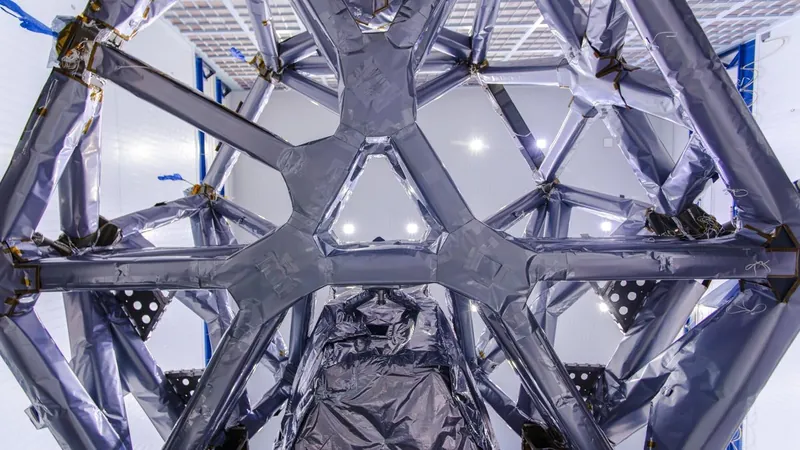
Bold Steps in Discovering Alien Worlds: NASA's Roman Space Telescope Set to Revolutionize Astronomy
2024-11-10
Author: Li
Integration of the Roman Coronagraph Instrument
In an impressive milestone at NASA's Jet Propulsion Laboratory in Southern California, scientists have successfully integrated an innovative component into the highly anticipated Roman Space Telescope. This essential piece of technology, known as the Roman Coronagraph Instrument, has the extraordinary capability to block overwhelming starlight, enabling astronomers to detect the faint glimmers from distant planets beyond our solar system.
Scheduled Launch and Scientific Mysteries
Scheduled for launch in May 2027, the Nancy Grace Roman Space Telescope is set to redefine our approach to exploring the cosmos. Boasting a field of view that is at least 100 times larger than that of the legendary Hubble Space Telescope, Roman will delve into vast scientific mysteries, ranging from the enigmatic nature of dark energy to the search for exoplanets and advances in infrared astrophysics.
Role of the Coronagraph Instrument
While the Roman Space Telescope will primarily utilize its Wide Field Instrument for scientific exploration, the Coronagraph Instrument serves a crucial role as a technology demonstration—a critical step toward future space missions like the proposed Habitable Worlds Observatory. This upcoming telescope, if realized, will be specifically designed to hunt for signs of life on other planets, marking an exhilarating new chapter in the quest for extraterrestrial life.
Advancements in Technology
Rob Zellem, Roman Space Telescope's deputy project scientist for communications at NASA Goddard, stated, "To advance from our current capabilities to where we aspire to be, we need the Roman Coronagraph to validate this technology." The lessons learned from this mission will undoubtedly pave the way for upcoming NASA flagship missions focused on finding Earth-like planets.
The Coronagraph's Design
The coronagraph itself, about the size of a baby grand piano, is an intricate assembly composed of masks, prisms, detectors, and self-adjusting mirrors. These sophisticated components work in harmony to eliminate the blinding glare of distant stars, making it possible for researchers to discern planets that orbit them.
Current Exoplanet Detection Methods
Currently, astronomers often rely on indirect methods to discover exoplanets, particularly a technique called transiting. This approach involves observing dips in the light of distant stars as exoplanets pass in front of them, providing crucial data about the planets’ atmospheric makeup and potential habitability. Notably, these methods can hint at gases potentially indicative of life.
Limitations of Traditional Methods
However, one of the major challenges with this approach is its inherent limitations. Only a tiny fraction of planets can be observed during their transits, which occurs only during a short window of their total orbital cycle. Furthermore, the orbital alignment must be nearly edge-on, a configuration that applies to only a select few distant exoplanets, resulting in many remaining hidden from detection via traditional photometry.
Direct Imaging Technologies
Advancements in direct imaging technologies have primarily focused on observing larger planets, which are oftentimes easier to spot due to their residual heat from formation. A striking example of this is the images captured of four exoplanets orbiting the star HR 8799, thanks to the efforts of astronomers utilizing data from Hawaii's Keck Observatory.
Future of Planet-Hunting
Moving forward, the Roman Coronagraph Instrument aims to harness the power of coronagraph technology to propel planet-hunting efforts to new heights, enabling the detection of planets that are 100 million times fainter than their host stars. This sensitivity is expected to be between 100 to 1,000 times greater than existing space-based coronagraphs.
Integration of Technology
Engineers at NASA have successfully integrated the coronagraph onto the telescope's Instrument Carrier, a vital structure that serves as the backbone of the observatory, interfacing with both the coronagraph and the Wide Field Instrument, which will be added later this year.
Engineering and Collaboration
Brandon Creager, lead mechanical engineer for the Roman Coronagraph at JPL, explained, “Think of the Instrument Carrier as the skeleton of the observatory. It’s essential for housing everything in the telescope.”
Looking Ahead
As the project progresses, engineering teams will conduct further tests and evaluations ahead of integrating the Wide Field Instrument, leading up to the culmination of the telescope's assembly. Liz Daly, who leads the integrated payload assembly and integration testing for Roman at Goddard, expressed the sheer satisfaction of witnessing the collaborative effort, stating, “It’s rewarding to see the immense dedication, hard work, and perseverance coming together to build the Roman observatory.”
Conclusion
The future of astronomy is on the brink of transformation, with the Roman Space Telescope set to unlock the secrets of the universe and perhaps bring us closer to answering the age-old question: are we alone in the cosmos? Keep your eyes on the skies!



 Brasil (PT)
Brasil (PT)
 Canada (EN)
Canada (EN)
 Chile (ES)
Chile (ES)
 España (ES)
España (ES)
 France (FR)
France (FR)
 Hong Kong (EN)
Hong Kong (EN)
 Italia (IT)
Italia (IT)
 日本 (JA)
日本 (JA)
 Magyarország (HU)
Magyarország (HU)
 Norge (NO)
Norge (NO)
 Polska (PL)
Polska (PL)
 Schweiz (DE)
Schweiz (DE)
 Singapore (EN)
Singapore (EN)
 Sverige (SV)
Sverige (SV)
 Suomi (FI)
Suomi (FI)
 Türkiye (TR)
Türkiye (TR)